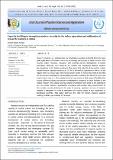The Significance of Stochastic CTMC Over Deterministic Model in Understanding the Dynamics of Lymphatic Filariasis With Asymptomatic Carriers

View/
Date
2024-05-04Author
Stephano, Mussa
Irunde, Jacob
Mayengo, Maranya
Kuznetsov, Dmitry
Metadata
Show full item recordAbstract
Lymphatic filariasis is a leading cause of chronic and irreversible damage to human immunity. This paper presents deterministic and continuous-time Markov chain (CTMC) stochastic models regarding lymphatic filariasis dynamics. To account for randomness and uncertainties in dynamics, the CTMC model was formulated based on deterministic model possible events. A deterministic model’s outputs suggest that disease extinction is feasible when the secondary threshold infection number is below one, while persistence becomes likely when the opposite holds true. Furthermore, the significant contribution of asymptomatic carriers was identified. Results indicate that persistence is more likely to occur when the infection results from asymptomatic, acutely infected, or infectious mosquitoes. Consequently, the CTMC stochastic model is essential in capturing variabilities, randomness, associated probabilities, and validity across different scales, whereas oversimplification and unpredictability of inherent may not be featured in a deterministic model.
